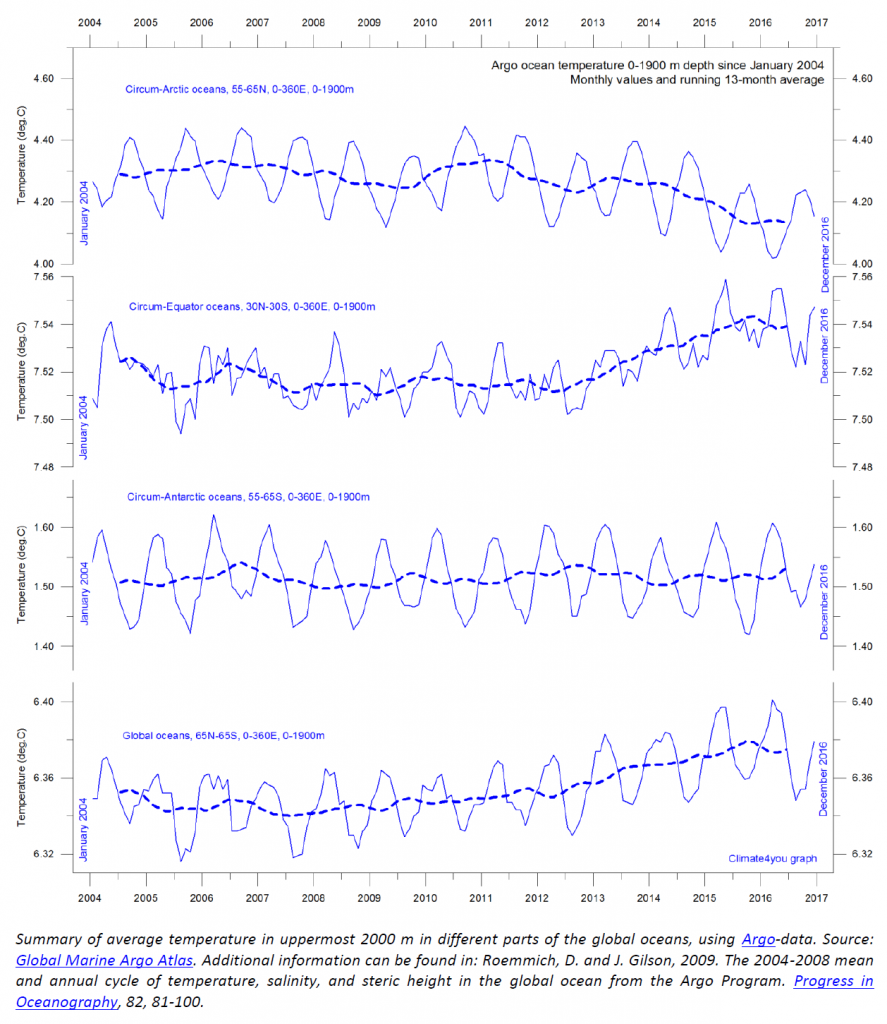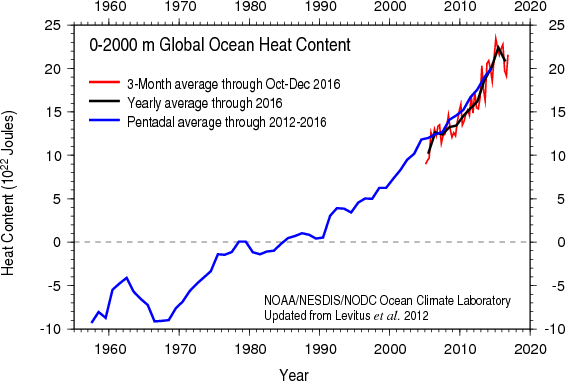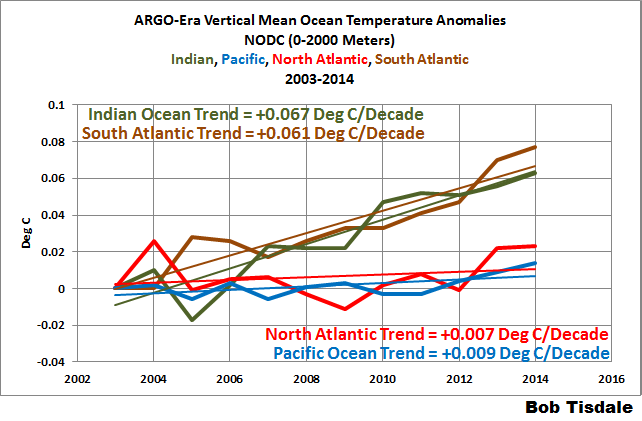Schock-News auf Spiegel Online am 12. März 2017:
Klimawandel: Ozeane erwärmen sich deutlich schneller als befürchtet
Es ist ein weiterer Beleg für den Klimawandel: Die Ozeane heizen sich immer schneller auf. Neue Daten zeigen, wie sehr sich Forscher in der Vergangenheit geirrt haben.
Der Untersuchung zufolge erwärmen sich die Ozeane rund 13 Prozent schneller als bisher gedacht. Hinzu kommt, dass sich der Prozess immer weiter beschleunigt. 1992 heizten sich die Ozeane bereits nahezu doppelt so schnell auf wie noch 1960, schreiben die Wissenschaftler im Fachblatt „Science Advances“. Erst seit 1990 erreiche die Erwärmung überhaupt Wassertiefen unter 700 Metern.
Es geht um einen Artikel von Cheng et al. 2017 in Science Advances:
Improved estimates of ocean heat content from 1960 to 2015
Earth’s energy imbalance (EEI) drives the ongoing global warming and can best be assessed across the historical record (that is, since 1960) from ocean heat content (OHC) changes. An accurate assessment of OHC is a challenge, mainly because of insufficient and irregular data coverage. We provide updated OHC estimates with the goal of minimizing associated sampling error. We performed a subsample test, in which subsets of data during the data-rich Argo era are colocated with locations of earlier ocean observations, to quantify this error. Our results provide a new OHC estimate with an unbiased mean sampling error and with variability on decadal and multidecadal time scales (signal) that can be reliably distinguished from sampling error (noise) with signal-to-noise ratios higher than 3. The inferred integrated EEI is greater than that reported in previous assessments and is consistent with a reconstruction of the radiative imbalance at the top of atmosphere starting in 1985. We found that changes in OHC are relatively small before about 1980; since then, OHC has increased fairly steadily and, since 1990, has increasingly involved deeper layers of the ocean. In addition, OHC changes in six major oceans are reliable on decadal time scales. All ocean basins examined have experienced significant warming since 1998, with the greatest warming in the southern oceans, the tropical/subtropical Pacific Ocean, and the tropical/subtropical Atlantic Ocean. This new look at OHC and EEI changes over time provides greater confidence than previously possible, and the data sets produced are a valuable resource for further study.
Hier die entsprechende Pressemitteilung von NCAR/UCAR:
New estimate of ocean heat finds more warming
Recent observations lead to a better understanding of the past
The oceans may be storing 13 percent more heat than previously estimated, according to a new study co-authored by scientists at the National Center for Atmospheric Research (NCAR). The finding, published in the journal Science Advances, is based on a new analysis of how ocean temperatures have changed since 1960. The research team, led by Lijing Cheng of the Chinese Academy of Sciences, compared their results to estimates published in the Fifth Assessment Report of the Intergovernmental Panel on Climate Change in 2013. „In other words, the planet is warming quite a lot more than we thought,“ said NCAR scientist Kevin Trenberth, a study co-author.
The vast majority of excess heat trapped on Earth by greenhouse gas emissions — about 90 percent — is stored in the oceans, but measuring how the heat content of the oceans has changed over time has been a challenge due to sparse observations. Historically, the temperature of ocean waters was measured by a variety of ships, but this limited observations to areas where ships traveled. In more recent decades, measurements of ocean heat have increased, thanks to new observational techniques. In 2000, scientists began deploying a network of thousands of floats called Argo to profile conditions in the top layer of the ocean extending down 2,000 meters (6,562 feet). Argo achieved near global coverage in 2005, though some remote regions are still not sampled.
To fill the large gaps in the historical ocean temperature record, the research team used a combination of statistical techniques and model output to determine how useful a single observation can be for inferring information about the surrounding area, as well as how the temperatures in different parts of the world’s oceans relate to one another. They found that, in most regions, a single ocean observation could provide valuable information about conditions as far as 2,000 kilometers (1,243 miles) away.
To check if they were correct, they used Argo observations. At first, they chose data from only a small number of floats in the network to mimic the scarcity of observations that would have been available in the mid-20th century. Then they used their new technique to create an entire ocean temperature map based on those few observations. When they checked their map against the full complement of Argo observations, they found that their reconstruction tracked closely with reality. „The results were remarkable,“ Trenberth said. „They give us much more confidence about what the ocean heat content was, stretching back to the late 1950s.“
The results allowed the team to estimate the total warming between 1960 and 2005 to be 337 zettajoules (a measure of energy). They also found that changes were small until 1980, when the amount of heat stored in the oceans began to steadily increase. Since 1990, significant amounts of heat have begun to seep deeper into the ocean layers. NCAR scientist and co-author John Fasullo said the study also highlights the impact of improved observations and models, which are giving scientists important insights into what the world once looked like. „Science not only looks toward the future, but is also continually trying to make sense of the past,“ he said. „This work is an example of how advances in technology have enabled an improved understanding of past changes in the ocean, where variability has always been a bit of an enigma due to its vastness and depth. The insights associated with this work change not only our understanding of past climate but also how future changes might unfold.“ The other co-authors are Tim Boyer, of the National Oceanic and Atmospheric Administration; John Abraham, of the University of St. Thomas; and Jiang Zhu, of the Chinese Academy of Sciences.
Wir wollen es genauer wissen und schauen in die offiziellen Daten zum ozeanischen Wärmeinhalt (ocean heat content, OHC). Climate4You hat die Daten für die obersten 2 km der Weltozeane (Abb. 1):

Abb. 1: Ozeanischer Wärmeinhalt (OHC) 2004-2017. Graphik: Climate4You.
Zu erkennen: Die Arktis kühlte sich zwischen 2004-2017 ab, Äquator erwärmt sich, Antarktis bleibt gleich. Global kommt für den OHC immer noch eine Erwärmung für diesen Zeitraum heraus. Wenn man sich die letzten zwei, drei Jahre anschaut, erspäht man etwas Interessantes: Das letzte Jahre (2016) scheint hier einen leichten Abkühlungstrend beim ozeanischen Wärmeinhalt aufzuweisen. Das wollen wir mit den OHC-Graphiken der NOAA (NODC) vergleichen:

Abb. 2: Globaler Ozeanischer Wärmeinhalt (OHC) der letzten 60 Jahre. Graphik: NOAA.
Ein ziemlich deutlicher Zappler nach unten. Ob sich hier eine Trendwende anbahnt, oder ist es nur eine kleine Verschnaufpause auf dem Weg zu noch höheren OHC-Werten? Der Nordatlantik und Pazifik scheinen sich im letzten Jahrzehnt kaum erwärmt zu haben, wie diese Graphik von Bob Tisdale auf Basis der ARGO-Daten (0 bis 2000 m Wassertiefe) zeigt:

Abb. 3: Entwicklung des ozeanischen Wärmeinhalts, aufgeschlüsselt nach Ozeanen. Graphik: Bob Tisdale, WUWT.
Wissenschaftler wunderten sich, dass sich die Wassermassen des großen Pazifik kaum erwärmt haben. Eine Forschergruppe um Sang-Ki Lee erklärte in Nature Geoscience, dass die Wärme wohl in den Indischen Ozean weitergewandert wäre. Im Indik hat sich der OHC in den letzten anderthalb Jahrzehnten kräftig erhöht (Abb. 3). Wie sieht es unterhalb von 2 km Wassertiefe aus? Wir schauen in eine Arbeit von Llovel et al. 2014 in Nature Climate Change hinein:
Deep-ocean contribution to sea level and energy budget not detectable over the past decade
As the dominant reservoir of heat uptake in the climate system, the world’s oceans provide a critical measure of global climate change. Here, we infer deep-ocean warming in the context of global sea-level rise and Earth’s energy budget between January 2005 and December 2013. Direct measurements of ocean warming above 2,000 m depth explain about 32% of the observed annual rate of global mean sea-level rise. Over the entire water column, independent estimates of ocean warming yield a contribution of 0.77 ± 0.28 mm yr−1 in sea-level rise and agree with the upper-ocean estimate to within the estimated uncertainties. Accounting for additional possible systematic uncertainties, the deep ocean (below 2,000 m) contributes −0.13 ± 0.72 mm yr−1 to global sea-level rise and −0.08 ± 0.43 W m−2 to Earth’s energy balance. The net warming of the ocean implies an energy imbalance for the Earth of 0.64 ± 0.44 W m−2 from 2005 to 2013.
Oder in anderen Worten: Der tiefe Ozean unterhalb von 2000 m hat sich von 2005-2013 abgekühlt! Passt nicht so gut zur Behauptung, der Ozean würde sich ingesamt schneller erwärmen als gedacht.